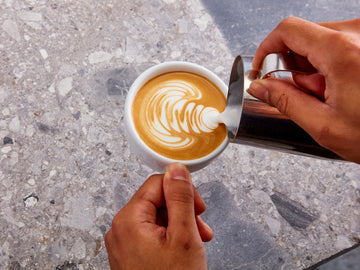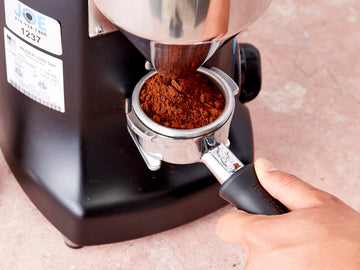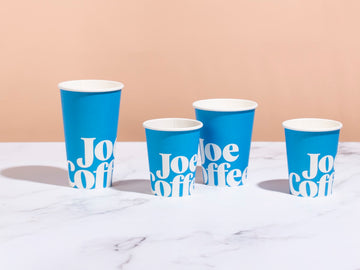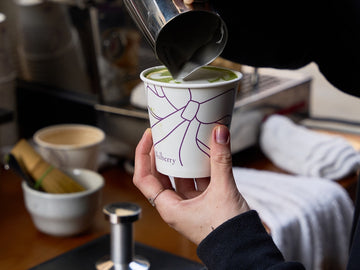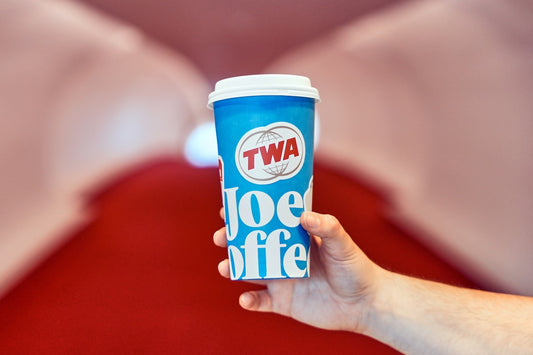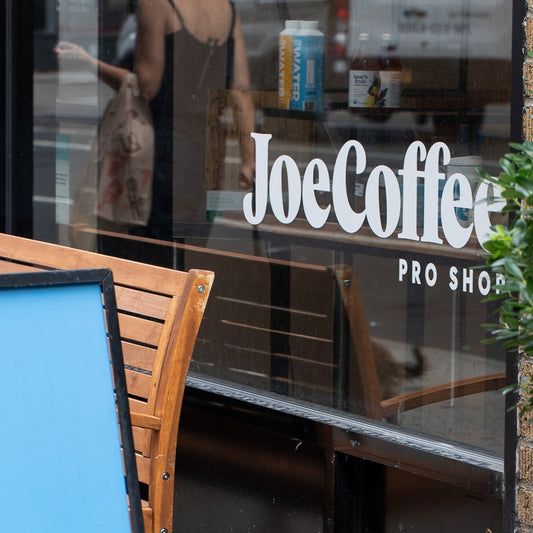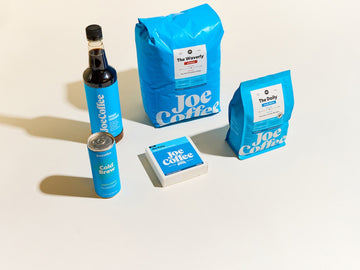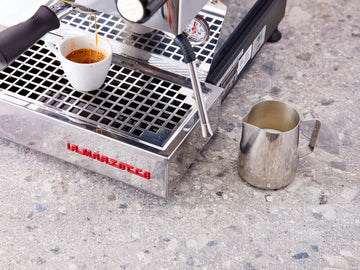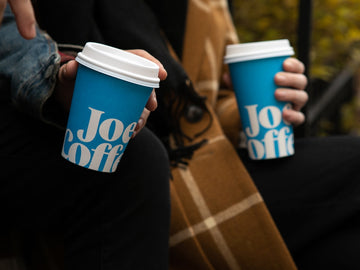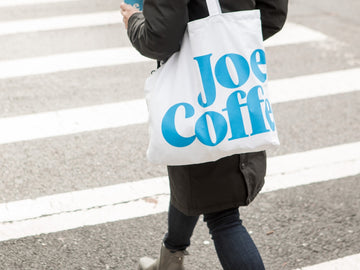Like many things at Joe, our relationship with Lincoln Center—and the collaboration that followed—came about quite naturally. A few years back, we hosted an Instagram contest where Joe Grandy, now the Director of Business Development and Innovation at Lincoln Center, was randomly selected as the winner. When Joe later joined the Lincoln Center team, he reconnected with our founder and CEO, Jonathan Rubinstein, and pitched an idea: what if we created a summer seasonal coffee inspired by our Rockefeller blend, but with proceeds supporting Lincoln Center?
In true Joe fashion, we brought the idea to our team and held an internal vote to choose an organization within Lincoln Center to support. The decision was clear—everyone was drawn to the Young Artist Pipeline (YAP), a program that nurtures young talent across a wide range of disciplines and helps make arts education accessible to kids who might not otherwise have these kinds of opportunities. To make the collaboration even more meaningful, students from YAP were invited to create artwork for the coffee bag, putting their creativity into action in a real-world project. This summer coffee resulted in nearly $7,000 raised through more than 12,665 round-up donations in our cafes, plus over 400 retail bags sold.
This year, we wanted to expand the impact and include even more students from across YAP’s five artistic disciplines: dance, theater, vocal music, instrumental music, and visual arts. To do that, we introduced five different versions of our Lincoln Center coffee, each in a 6 oz bag and featuring original artwork inspired by each discipline.

Over the course of several weekends at LaGuardia High School we spent time with the students, getting to know their work and watching them practice their craft. Vocal, theater, and instrumental students were photographed mid-performance, and those images were later transformed into striking silhouettes. Dance students painted their feet, posed in expressive positions, and turned those prints into captivating visuals. Visual arts students were asked to design icons that represented what YAP meant to them. The result is five beautifully designed, deeply personal bags of Lincoln Center coffee—a testament to the creativity of these young artists and the important work Lincoln Center is doing to support the next generation of talent.
We sat down with Dacia Washington, Lincoln Center’s Director of Emergent Artist Initiatives, to talk about how the Young Artist Pipeline came to life, the personal passion that fuels her work, and what keeps her moving forward at a time when both the arts and DEIA initiatives face increasing challenges under the current administration.
Can you share a bit about your background and how the arts shaped your early life and path into education?
I am a proud native NYer, having grown up on the northern tip of Manhattan in Inwood Heights. I had an eclectic artistic education, that included studying ballet, violin, cello, fine arts, and eventually performing in community theater. My mother believed in the value of artistic practice and did all that she could to ensure that I was able to participate in the arts. Alongside formal studies, my family was always attending performances, and the world of artists, seemed more of a norm for me than other career paths. It seemed inevitable that I would eventually attend the School of Performing Arts (now LaGuardia HS), and not a Math and Science school where I also was admitted. Through that experience, I was immersed in a diverse community emerging artists, and my exposure to the arts widened and deepened. I was not fully aware until I was an adult that access to the arts is not a given for all. Because I have a deep love and appreciation for performance and my own artistry, it is an imperative for me to do what I can to provide rich, unique, and engaging experiences for young people.
Who or what inspired you most growing up—and how does that influence the way you support young artists today?
I come from a family of artists, musicians and performers, so there was never a time in my upbringing when the arts were not central to my growth and development. Both of my parents were musicians and educators. I had the opportunity to see them perform professionally in clubs, concert halls, touring, and on Broadway, as well as see them cultivating the next generation of artists, some of whom went on to professions in the arts. What continues to impress me about their legacy is that not only did they provide access to the arts for NYC students, but they also created a community and legacy that continues today. Even though most of the folks that they worked with did not go on to careers in the arts, they attribute their successes and best memories to their time in the programs that they facilitated. This inspires me to think about not just what young people learn, but how they learn to interact with each other and evolve their world view. Most importantly, how are we consciously forming communities that resonate with and through the arts?
You’ve spent your career at the intersection of arts and education. What changes have you seen over the years, and what shifts do you still hope to see?
I have seen many changes throughout the years. As a child, I grew up in the Bronx Boro-Wide Chorus, where my mother was alto instructor and accompanist, and my father was conductor. Because I had to be there on Saturday mornings, I participated and began my singing career at the age of 5 in the soprano section. Music and arts programs in the schools, at the time, were robust and many world class musicians had their earliest training in them. Due to the fiscal crisis in the 1970s, there were devastating cuts to the arts. The training, recruitment, and cultivation of artist teachers was deprioritized, and many schools eliminated arts programming. In the 1990s,
through the founding of the Center for Arts Education and funding through the Annenberg Foundation, arts organizations received a needed boost to support arts education in NYC public schools. What I would most like to see is a greater valuing of the arts as intrinsic, essential aspect of education and social emotional wellness in that they encourage community, can engage empathy, present opportunities for problem solving. Through the arts we can develop the capacity to imagine other possibilities, and the rigor to work toward them as a society. I would like to see a value proposition that brings with it adequate funding, training opportunities, and increased access for all. "The arts are not for the privileged few, but for the many. Their place is not on the periphery of daily life, but at its center; they should function not merely as another form of entertainment but, rather, should contribute significantly to our wellbeing and happiness. " This quote is on a memorial plaque honoring John D. Rockefeller III, the founder of Lincoln Center and for me it is a north star. As I consider possible programming opportunities and future shifts, I keep this principle in the foreground to ensure that the arts are centered, participants have agency.
What does it mean to give students real-world opportunities like the Lincoln Center coffee collaboration—and how do you think it prepares them for life beyond the classroom?
The Lincoln Center/Joe Coffee collaboration has been amazing for the students. They have had the opportunity to witness and be instrumental in a collaboration that takes them through a creative process resulting in a product that features their artistry. The project makes the connection between one’s artistry to career pathways. It inspires them to view objects, packaging, and advertising through a design lens. The self- esteem that comes from being featured in the campaign is undeniable. I have no doubt that students will remember having been essential contributors.
This year’s expanded collaboration featured five student-designed bags. What was the creative process like, and how do you ensure each student’s voice is honored?
Ned Semoff was instrumental in the inspiration for this year’s expanded collaboration. I am so grateful that all studios in the program were featured. Each student makes their mark on the design related to their studio: posing in an inspired way, painting then printing their feet, creating a drawing related to the arts. Each student’s signature is featured in the design as well. It’s an exciting process for the students and initially they are unsure of the outcome. Ned does an amazing job of designing the bags. I am so excited for the students to see the final product.
What impact do partnerships like this have on students’ confidence, creativity, and sense of possibility?
The impact is immeasurable, but I will say that this partnership, now in its second year is one of the unique aspects of the program. I am hopeful that as the program goes forward that we will be able to have more opportunities for students to experience how
artistry is applied in meaningful careers. Too often the arts are deemed less valuable as a pursuit because of financial stability, but if you ask people about their experience in the arts and whether what they learned has value in their current careers, they highlight direct and indirect correlations. The students who were in the program last year were thrilled to hear that Joe Coffee would be back this year. One of the aspects of the program that they highlight in their testimonials is the opportunity to work with professionals in the field. Through the partnership with Joe Coffee, they experience how creativity, imagination, and design are essential in product packaging and marketing.
At a time when arts and DEIA programs face growing challenges, what’s one thing you want people to know about YAP—and how can they help support its future?
In the face of growing challenges, the arts are essential. Identifying barriers to participation in the arts for young people is critical. Arts organizations hold space for people when other systems fail. I guess what I want people to know about Young Artist Pipeline is that we are and hope to always be a community in the making for aspiring artists. We are dedicated to being responsive to the participants, challenging them to develop artist citizens, to be actively curious about the world, and consider how that disposition influences them as art makers. That’s more than one thing, but in short, we are here for middle school students who are curious about the arts and want to commit themselves to exploring and developing their artistic and imaginative capacities.
—
Lincoln Center is now available for purchase online and in-cafes. $1 from every bag supports Lincoln Center and the Young Artist Pipeline.


